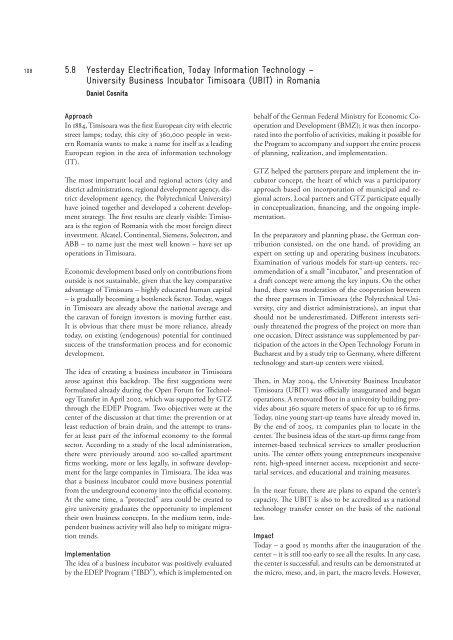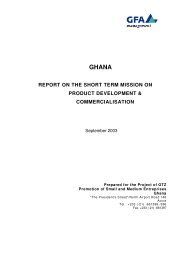Local/Regional Economic Development in South ... - Value Chains
Local/Regional Economic Development in South ... - Value Chains
Local/Regional Economic Development in South ... - Value Chains
You also want an ePaper? Increase the reach of your titles
YUMPU automatically turns print PDFs into web optimized ePapers that Google loves.
108<br />
5.8 Yesterday Electrification, Today Information Technology –<br />
University Bus<strong>in</strong>ess Incubator Timisoara (UBIT) <strong>in</strong> Romania<br />
Daniel Cosnita<br />
Approach<br />
In 1884, Timisoara was the first European city with electric<br />
street lamps; today, this city of 360,000 people <strong>in</strong> western<br />
Romania wants to make a name for itself as a lead<strong>in</strong>g<br />
European region <strong>in</strong> the area of <strong>in</strong>formation technology<br />
(IT).<br />
The most important local and regional actors (city and<br />
district adm<strong>in</strong>istrations, regional development agency, district<br />
development agency, the Polytechnical University)<br />
have jo<strong>in</strong>ed together and developed a coherent development<br />
strategy. The first results are clearly visible: Timisoara<br />
is the region of Romania with the most foreign direct<br />
<strong>in</strong>vestment. Alcatel, Cont<strong>in</strong>ental, Siemens, Solectron, and<br />
ABB – to name just the most well known – have set up<br />
operations <strong>in</strong> Timisoara.<br />
<strong>Economic</strong> development based only on contributions from<br />
outside is not susta<strong>in</strong>able, given that the key comparative<br />
advantage of Timisoara – highly educated human capital<br />
– is gradually becom<strong>in</strong>g a bottleneck factor. Today, wages<br />
<strong>in</strong> Timisoara are already above the national average and<br />
the caravan of foreign <strong>in</strong>vestors is mov<strong>in</strong>g further east.<br />
It is obvious that there must be more reliance, already<br />
today, on exist<strong>in</strong>g (endogenous) potential for cont<strong>in</strong>ued<br />
success of the transformation process and for economic<br />
development.<br />
The idea of creat<strong>in</strong>g a bus<strong>in</strong>ess <strong>in</strong>cubator <strong>in</strong> Timisoara<br />
arose aga<strong>in</strong>st this backdrop. The first suggestions were<br />
formulated already dur<strong>in</strong>g the Open Forum for Technology<br />
Transfer <strong>in</strong> April 2002, which was supported by GTZ<br />
through the EDEP Program. Two objectives were at the<br />
center of the discussion at that time: the prevention or at<br />
least reduction of bra<strong>in</strong> dra<strong>in</strong>, and the attempt to transfer<br />
at least part of the <strong>in</strong>formal economy to the formal<br />
sector. Accord<strong>in</strong>g to a study of the local adm<strong>in</strong>istration,<br />
there were previously around 200 so-called apartment<br />
firms work<strong>in</strong>g, more or less legally, <strong>in</strong> software development<br />
for the large companies <strong>in</strong> Timisoara. The idea was<br />
that a bus<strong>in</strong>ess <strong>in</strong>cubator could move bus<strong>in</strong>ess potential<br />
from the underground economy <strong>in</strong>to the official economy.<br />
At the same time, a “protected” area could be created to<br />
give university graduates the opportunity to implement<br />
their own bus<strong>in</strong>ess concepts. In the medium term, <strong>in</strong>dependent<br />
bus<strong>in</strong>ess activity will also help to mitigate migration<br />
trends.<br />
Implementation<br />
The idea of a bus<strong>in</strong>ess <strong>in</strong>cubator was positively evaluated<br />
by the EDEP Program (“IBD”), which is implemented on<br />
behalf of the German Federal M<strong>in</strong>istry for <strong>Economic</strong> Cooperation<br />
and <strong>Development</strong> (BMZ); it was then <strong>in</strong>corporated<br />
<strong>in</strong>to the portfolio of activities, mak<strong>in</strong>g it possible for<br />
the Program to accompany and support the entire process<br />
of plann<strong>in</strong>g, realization, and implementation.<br />
GTZ helped the partners prepare and implement the <strong>in</strong>cubator<br />
concept, the heart of which was a participatory<br />
approach based on <strong>in</strong>corporation of municipal and regional<br />
actors. <strong>Local</strong> partners and GTZ participate equally<br />
<strong>in</strong> conceptualization, f<strong>in</strong>anc<strong>in</strong>g, and the ongo<strong>in</strong>g implementation.<br />
In the preparatory and plann<strong>in</strong>g phase, the German contribution<br />
consisted, on the one hand, of provid<strong>in</strong>g an<br />
expert on sett<strong>in</strong>g up and operat<strong>in</strong>g bus<strong>in</strong>ess <strong>in</strong>cubators.<br />
Exam<strong>in</strong>ation of various models for start-up centers, recommendation<br />
of a small “<strong>in</strong>cubator,” and presentation of<br />
a draft concept were among the key <strong>in</strong>puts. On the other<br />
hand, there was moderation of the cooperation between<br />
the three partners <strong>in</strong> Timisoara (the Polytechnical University,<br />
city and district adm<strong>in</strong>istrations), an <strong>in</strong>put that<br />
should not be underestimated. Different <strong>in</strong>terests seriously<br />
threatened the progress of the project on more than<br />
one occasion. Direct assistance was supplemented by participation<br />
of the actors <strong>in</strong> the Open Technology Forum <strong>in</strong><br />
Bucharest and by a study trip to Germany, where different<br />
technology and start-up centers were visited.<br />
Then, <strong>in</strong> May 2004, the University Bus<strong>in</strong>ess Incubator<br />
Timisoara (UBIT) was officially <strong>in</strong>augurated and began<br />
operations. A renovated floor <strong>in</strong> a university build<strong>in</strong>g provides<br />
about 360 square meters of space for up to 16 firms.<br />
Today, n<strong>in</strong>e young start-up teams have already moved <strong>in</strong>.<br />
By the end of 2005, 12 companies plan to locate <strong>in</strong> the<br />
center. The bus<strong>in</strong>ess ideas of the start-up firms range from<br />
<strong>in</strong>ternet-based technical services to smaller production<br />
units. The center offers young entrepreneurs <strong>in</strong>expensive<br />
rent, high-speed <strong>in</strong>ternet access, receptionist and secretarial<br />
services, and educational and tra<strong>in</strong><strong>in</strong>g measures.<br />
In the near future, there are plans to expand the center’s<br />
capacity. The UBIT is also to be accredited as a national<br />
technology transfer center on the basis of the national<br />
law.<br />
Impact<br />
Today – a good 15 months after the <strong>in</strong>auguration of the<br />
center – it is still too early to see all the results. In any case,<br />
the center is successful, and results can be demonstrated at<br />
the micro, meso, and, <strong>in</strong> part, the macro levels. However,



